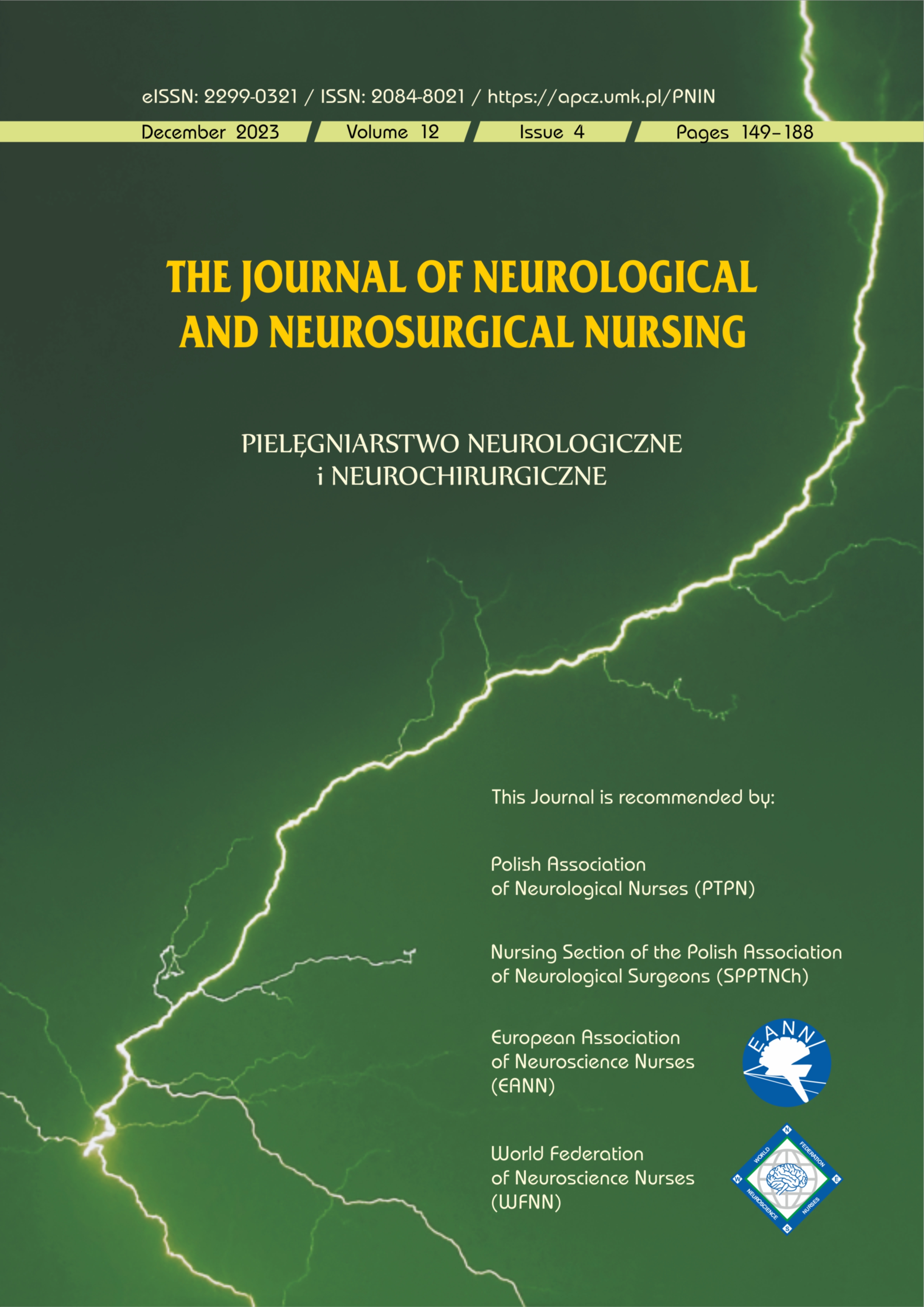The Impact of Selected Lifestyle Factors on the Functional Fitness of Stroke Patients during the Covid-19 Pandemic
DOI:
https://doi.org/10.15225/PNN.2023.12.4.2Keywords
functional capacity, nursing care, risk factors, strokeAbstract
Introduction. Stroke is the cause of death in approximately 30,000 Poles yearly. Assessment of the functional capacity of patients after stroke and the factors influencing its course is utterly important because it allows to determine the level of nursing care need.
Aim. The aim of the study was to assess the functional capacity of patients after stroke and the impact of lifestyle-related stroke risk factors on the effectiveness of rehabilitation depending on the type of stroke suffered during the Covid-19 pandemic.
Material and Methods. The study group included 89 patients (38 women and 51 men) after hemorrhagic or ischemic stroke hospitalized under early neurological rehabilitation. Functional fitness was assessed using the 20-point Barthel scale and the NHPT(Nine Hole Peg Test) test to assess hand function.
Results. The study reported a statistically significant impact of rehabilitation on the functional capacity of patients after stroke. The age influence on the type of stroke was also noticed — people with ischemic stroke were older compared to people with hemorrhagic stroke. Stroke patients with diabetes, hypertension or obesity achieved statistically worse results compared to patients without these comorbidities.
Conclusions. Age is an important risk factor for ischemic stroke. Furthermore people after stroke who suffer from diabetes, hypertension and obesity require more intensive rehabilitation. (JNNN 2023;12(4):157–163)
References
e-zdrowie, NFZ o zdrowiu. Udar niedokrwienny mózgu. https://ezdrowie.gov.pl/5618 [dostęp: 21.01.2024].
Kumari A., Ranjan P., Vikram N.K. et al. A short questionnaire to assess changes in lifestyle-related behaviour during COVID 19 pandemic. Diabetes Metab Syndr. 2020;14(6):1697–1701.
Uchino K., Kolikonda M.K., Brown D. et al. Decline in Stroke Presentations During COVID-19 Surge. Stroke. 2020;51(8):2544–2547.
Wójcik G., Piskorz J., Bulikowski W. Klinimetryczne metody oceny chorych po udarach mózgu w planowaniu rehabilitacji w populacji osób dorosłych. Hygeia Public Health. 2015;50(1):54–58.
Kiliç M.C., Başakçı Çalık B., Çobankara V., Balkarlı A. The Relationship Between Hand Function and Activity Performance in Patients with Rheumatoid Arthritis. EJMI. 2018;2(3):161–167.
Markus H.S., Brainin M. COVID-19 and stroke-A global World Stroke Organization perspective. Int J Stroke. 2020;15(4):361–364.
Raciborski F., Gujski M. (Red.), Udary mózgu — rosnący problem w starzejącym się społeczeństwie. Instytut Ochrony Zdrowia, Warszawa 2016.
Cabanas-Valdés R., Bagur-Calafat C., Girabent-Farrés M., Caballero-Gómez F.M., Hernández-Valiño M., Urrútia Cuchí G. The effect of additional core stability exercises on improving dynamic sitting balance and trunk control for subacute stroke patients: a randomized controlled trial. Clin Rehabil. 2016;30(10):1024–1033.
Kałużny K., Kałużna A., Kochański B. i wsp. Wpływ rehabilitacji neurologicznej na funkcjonowanie pacjentów po przebytym udarze niedokrwiennym mózgu — analiza retrospektywna. J Educ Health Sport. 2016;6(12):38–52.
Liu F., Tsang R.C., Zhou J. et al. Relationship of Barthel Index and its Short Form with the Modified Rankin Scale in acute stroke patients. J Stroke Cerebrovasc Dis. 2020;29(9):105033.
Thrane G., Askim T., Stock R. et al. Efficacy of Constraint-Induced Movement Therapy in Early Stroke Rehabilitation: A Randomized Controlled Multisite Trial. Neurorehabil Neural Repair. 2015;29(6):517–525.
Adamczyk K. Pielęgnowanie chorych po udarach mózgowych. Wyd. Czelej, Lublin 2003.
Niewada M., Michel P. Lifestyle modification for stroke prevention: facts and fiction. Curr Opin Neurol. 2016;29(1):9–13.
O’Donnell M.J., Chin S.L., Rangarajan S. et al. Global and regional effects of potentially modifiable risk factors associated with acute stroke in 32 countries (INTERSTROKE): a case-control study. Lancet. 2016;388(10046):761–775.
Sedova P., Brown R.D., Zvolsky M. et al. Incidence of Stroke and Ischemic Stroke Subtypes: A Community-Based Study in Brno, Czech Republic. Cerebrovasc Dis. 2021;50(1):54–61.
Członkowska A., Bembenek J.P. Nadciśnienie tętnicze u chorych z udarem niedokrwiennym mózgu. Kardiol Dypl. 2013;12(3):21–26.
Buonacera A., Stancanelli B., Malatino L. Stroke and Hypertension: An Appraisal from Pathophysiology to Clinical Practice. Curr Vasc Pharmacol. 2019;17(1):72–84.
Kapica-Topczewska K., Golec W., Kulikowska J. i wsp. Analiza czynników ryzyka i charakterystyka kliniczna pacjentów z udarem mózgu hospitalizowanych w Klinice Neurologii UM w Białymstoku w 2016 roku. Post Nauk Med. 2020;1:4–11.
Kleinrok A., Płaczkiewicz D., Stefańczyk P., Kudrelek K. Wpływ wybranych czynników socjodemograficznych i klinicznych na stopień niepełnosprawności pacjentów hospitalizowanych z powodu udaru mózgu. Prz Med Uniw Rzesz Inst Leków. 2013;2:151–163.
Iwase M., Komorita Y., Ohkuma T. et al. Incidence of stroke and its association with glycemic control and lifestyle in Japanese patients with type 2 diabetes mellitus: The Fukuoka diabetes registry. Diabetes Res Clin Pract. 2021;172:108518.
Forlivesi S., Cappellari M., Bonetti B. Obesity paradox and stroke: a narrative review. Eat Weight Disord. 2021;26(2):417–423.
Strepikowska A., Buciński A. Udar mózgu — czynniki ryzyka i profilaktyka. Postępy Farmakoterapii. 2009;65(1):46–50.
Towfighi A., Cheng E.M., Hill V.A. et al. Results of a Pilot Trial of a Lifestyle Intervention for Stroke Survivors: Healthy Eating and Lifestyle after Stroke. J Stroke Cerebrovasc Dis. 2020;29(12):105323.
Redfern J., McKevitt C., Dundas R., Rudd A.G., Wolfe C.D. Behavioral risk factor prevalence and lifestyle change after stroke: a prospective study. Stroke. 2000;31(8):1877–1881.
Downloads
Published
How to Cite
Issue
Section
License

This work is licensed under a Creative Commons Attribution-NoDerivatives 4.0 International License.
Stats
Number of views and downloads: 338
Number of citations: 0
